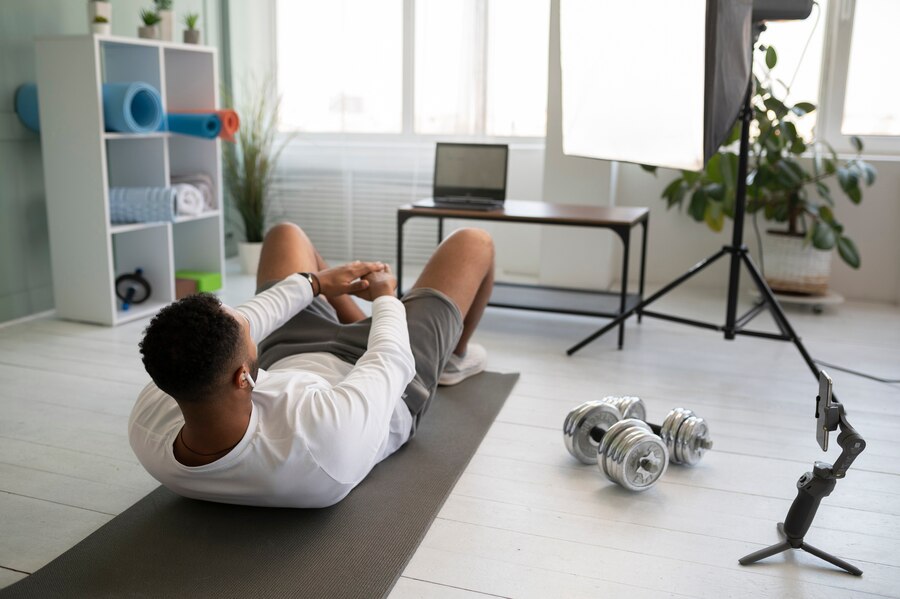How to Create a Home Gym Setup” Here’s a structured guide on setting up a home gym in both table format and detailed description. This setup will focus on essential aspects like location, equipment, safety considerations, and personalization to create a functional, motivating space.
Detailed Table for Home Gym Setup
| Category | Details |
|---|---|
| Location and Space | Choose a dedicated area with enough space (e.g., basement, garage, or spare room) for safe movement and comfort. |
| Budget Planning | Set a budget; prioritize essentials like dumbbells and mats, then add based on needs and funds. |
| Flooring | Use rubber mats or foam tiles to protect flooring, reduce noise, and provide comfort. |
| Basic Equipment | Start with versatile items like dumbbells, kettlebells, resistance bands, and an exercise mat. |
| Cardio Equipment | Depending on space and budget, consider a treadmill, stationary bike, or jump rope. |
| Strength Equipment | Add a squat rack, adjustable bench, barbell with weights, and pull-up bar if space allows. |
| Storage Solutions | Install shelves or wall hooks for organized storage, maximizing space and accessibility. |
| Mirrors | Add mirrors to monitor form, improve lighting, and create a more open feel. |
| Lighting | Use bright LED lights or natural light to create an energized environment. |
| Sound System | Include a speaker or wireless headphones for workout motivation through music. |
| Cooling and Ventilation | Add a fan or dehumidifier to maintain airflow and comfort, especially in enclosed areas. |
| Safety and Accessories | Place a first aid kit, workout towels, and water nearby; use equipment with safety features like grips. |
| Digital Setup | Consider a tablet or TV for online workouts, apps, or virtual training programs. |
| Personalization | Add posters, plants, or colors that create a motivating and personalized space. |
| Maintenance Routine | Regularly clean equipment, check for wear, and keep the space organized and clutter-free. |
In-Depth Guide on Creating a Home Gym Setup
Creating a home gym can enhance your fitness journey by providing a convenient, motivating space tailored to your needs. Here’s a detailed step-by-step approach to designing and setting up a home gym.
1. Selecting the Right Location and Space
Begin by choosing a location with ample room, such as a basement, garage, or spare room. This space should allow for free movement, equipment placement, and ensure safety. Having a dedicated area avoids disruptions and creates a consistent workout environment. A space of around 100-150 square feet is generally ideal for a basic setup, though you can work with smaller or larger areas depending on your needs.
2. Budgeting Wisely
Setting a budget helps you prioritize your equipment. Start with essentials that offer the most versatility, like dumbbells, an exercise mat, and resistance bands. As funds allow, add equipment that aligns with your fitness goals, such as cardio machines, a squat rack, or kettlebells. Investing in quality, durable items ensures long-term usability.

3. Flooring for Comfort and Safety
Rubber mats or foam tiles are recommended for home gyms, providing a cushioned surface that’s easy on your joints, reduces noise, and protects your floors. This type of flooring is also easy to clean and prevents equipment from slipping, adding a layer of safety to your workouts.
4. Essential Equipment Choices
For beginners, start with versatile equipment like adjustable dumbbells, kettlebells, resistance bands, and an exercise mat. These items cover a wide range of exercises for strength, flexibility, and cardio. As you progress, consider adding a squat rack, adjustable bench, barbell with weights, and a pull-up bar if your space and budget allow.
5. Cardio Equipment
If you enjoy cardio workouts, consider adding a treadmill, stationary bike, or rowing machine based on your space. For limited spaces, a jump rope or resistance bands can offer effective cardio training without occupying too much room.
6. Organizing with Storage Solutions
Maintaining a clean and organized space is crucial. Wall-mounted racks, hooks, or shelves help store equipment and maximize floor space. Having designated storage prevents clutter and allows easy access to your workout tools.
7. Adding Mirrors for Form and Ambiance
Mirrors are beneficial for monitoring your form, especially during weight training. They also reflect light and make a smaller space feel larger and more open, creating an ideal workout atmosphere.
8. Lighting for Energy
Bright lighting is essential for any gym space. LED lights work well as they’re energy-efficient and provide clear visibility. Natural light is also highly beneficial, so if possible, choose a space with windows. Good lighting keeps the area energized and ensures safe movement.
9. Sound and Motivation
A sound system or wireless headphones enhance the workout experience, keeping you motivated with your favorite music or workout playlists. If space permits, a Bluetooth speaker or a connected sound system can offer immersive sound.
10. Ventilation and Cooling
Gyms often get warm, so consider adding a fan, air purifier, or dehumidifier to maintain airflow and cool temperatures. Proper ventilation prevents the area from feeling stuffy and ensures a more comfortable workout environment.
11. Safety Accessories
Safety is paramount in a home gym. Keep a first aid kit nearby for minor injuries, and ensure a water station is accessible. Equipment with secure grips, non-slip mats, and good ventilation further add to a safe workout setting.
12. Digital Integration for Guided Workouts
For added variety, consider a tablet or TV mounted on the wall for streaming workout apps, guided classes, or virtual training sessions. Digital integration helps you follow along with workout programs, adding motivation and variety to your routines
Conclusion
Creating a home gym that fits your lifestyle is a rewarding way to stay active and focused on your fitness goals. By following these steps, you can design a space that’s both functional and motivating, providing everything you need for effective workouts. From essential equipment to personalized decor, every aspect contributes to a gym that keeps you engaged and consistent on your fitness journey.

